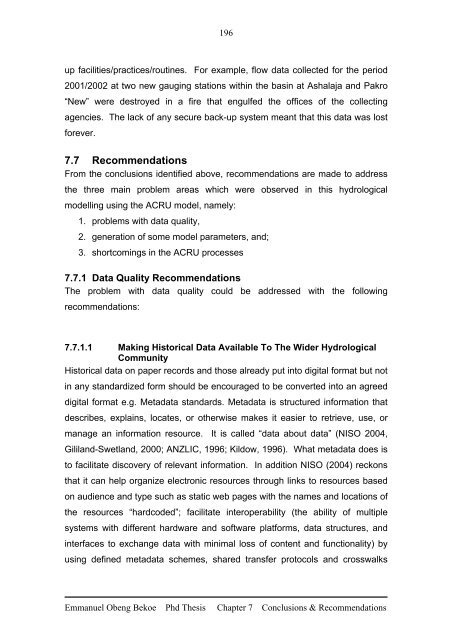PhD Thesis Emmanuel Obeng Bekoe - Cranfield University
PhD Thesis Emmanuel Obeng Bekoe - Cranfield University
PhD Thesis Emmanuel Obeng Bekoe - Cranfield University
You also want an ePaper? Increase the reach of your titles
YUMPU automatically turns print PDFs into web optimized ePapers that Google loves.
196<br />
up facilities/practices/routines. For example, flow data collected for the period<br />
2001/2002 at two new gauging stations within the basin at Ashalaja and Pakro<br />
“New” were destroyed in a fire that engulfed the offices of the collecting<br />
agencies. The lack of any secure back-up system meant that this data was lost<br />
forever.<br />
7.7 Recommendations<br />
From the conclusions identified above, recommendations are made to address<br />
the three main problem areas which were observed in this hydrological<br />
modelling using the ACRU model, namely:<br />
1. problems with data quality,<br />
2. generation of some model parameters, and;<br />
3. shortcomings in the ACRU processes<br />
7.7.1 Data Quality Recommendations<br />
The problem with data quality could be addressed with the following<br />
recommendations:<br />
7.7.1.1 Making Historical Data Available To The Wider Hydrological<br />
Community<br />
Historical data on paper records and those already put into digital format but not<br />
in any standardized form should be encouraged to be converted into an agreed<br />
digital format e.g. Metadata standards. Metadata is structured information that<br />
describes, explains, locates, or otherwise makes it easier to retrieve, use, or<br />
manage an information resource. It is called “data about data” (NISO 2004,<br />
Gililand-Swetland, 2000; ANZLIC, 1996; Kildow, 1996). What metadata does is<br />
to facilitate discovery of relevant information. In addition NISO (2004) reckons<br />
that it can help organize electronic resources through links to resources based<br />
on audience and type such as static web pages with the names and locations of<br />
the resources “hardcoded”; facilitate interoperability (the ability of multiple<br />
systems with different hardware and software platforms, data structures, and<br />
interfaces to exchange data with minimal loss of content and functionality) by<br />
using defined metadata schemes, shared transfer protocols and crosswalks<br />
<strong>Emmanuel</strong> <strong>Obeng</strong> <strong>Bekoe</strong> Phd <strong>Thesis</strong> Chapter 7 Conclusions & Recommendations

















